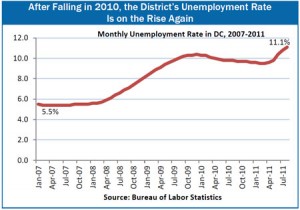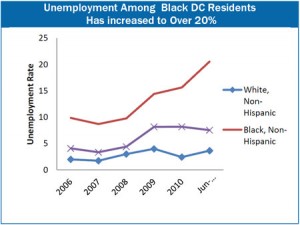After starting to fall in 2010, DC’s unemployment rate is on the rise again in 2011. As of August, the unemployment rate had reached 11.1 percent, up from 9.6 percent at the end of 2010. Unemployment among DC residents is now even higher than in the peak of the recession in late 2009.
Who are the District’s unemployed residents? An analysis of monthly data from the Census Bureau’s Current Population Survey shows that the increase in unemployment in DC has been widespread, but that DC’s most economically vulnerable residents continue to be hurt by the recession and weak economy. The residents most likely to be unemployed have low levels of formal education and are in low-wage occupations.
increase in unemployment in DC has been widespread, but that DC’s most economically vulnerable residents continue to be hurt by the recession and weak economy. The residents most likely to be unemployed have low levels of formal education and are in low-wage occupations.
DCFPI will be tracking changes in unemployment on a quarterly basis, looking at how the rate has changed overall but also among groups of DC residents. We will look at unemployment by education, race/ethnicity, age, and occupation. This analysis focuses on unemployment between June and August 2011, the most recent three months for which data are available.
Recent increases in unemployment rates have been concentrated in minority groups, low-wage occupations, and the older population.
- The unemployment rate in the District is now higher than during the official recession. DC’s unemployment rate peaked at 10.4 percent in December 2009, before starting to fall modestly in 2010. The recent rise in unemployment ‘ to 11.1 percent in August 2011 ‘ has surpassed even that rate.

- Unemployment among Black residents has risen notably. The unemployment rate for Black residents has increased sharply in 2011, on top of large increases in the recession. The recent unemployment rate for Black residents ‘ 20.4 percent in June-August 2011 ‘ represented a one-third increase since last year.
- Low-wage workers have seen a sharp rise in unemployment. This group has consistently faced higher unemployment than medium and high-wage workers, but the rate has increased substantially in the past year. Unemployment among workers in the lowest wage occupations rose from 16.1 percent in 2010 to 18.9 percent in June-August of this year.
- Older workers have seen a large increase in unemployment recently. Unemployment for 45 to 64 year old workers jumped from 8.2 percent in 2010 to 11.9 percent in the June-August 2011 period.
The recent increase in unemployment in the District has affected vulnerable populations who are having special trouble enduring these difficult economic times. The economic recovery is far from complete, so it is important to consider policies to support these populations with high unemployment rates — like income supports and job training.
